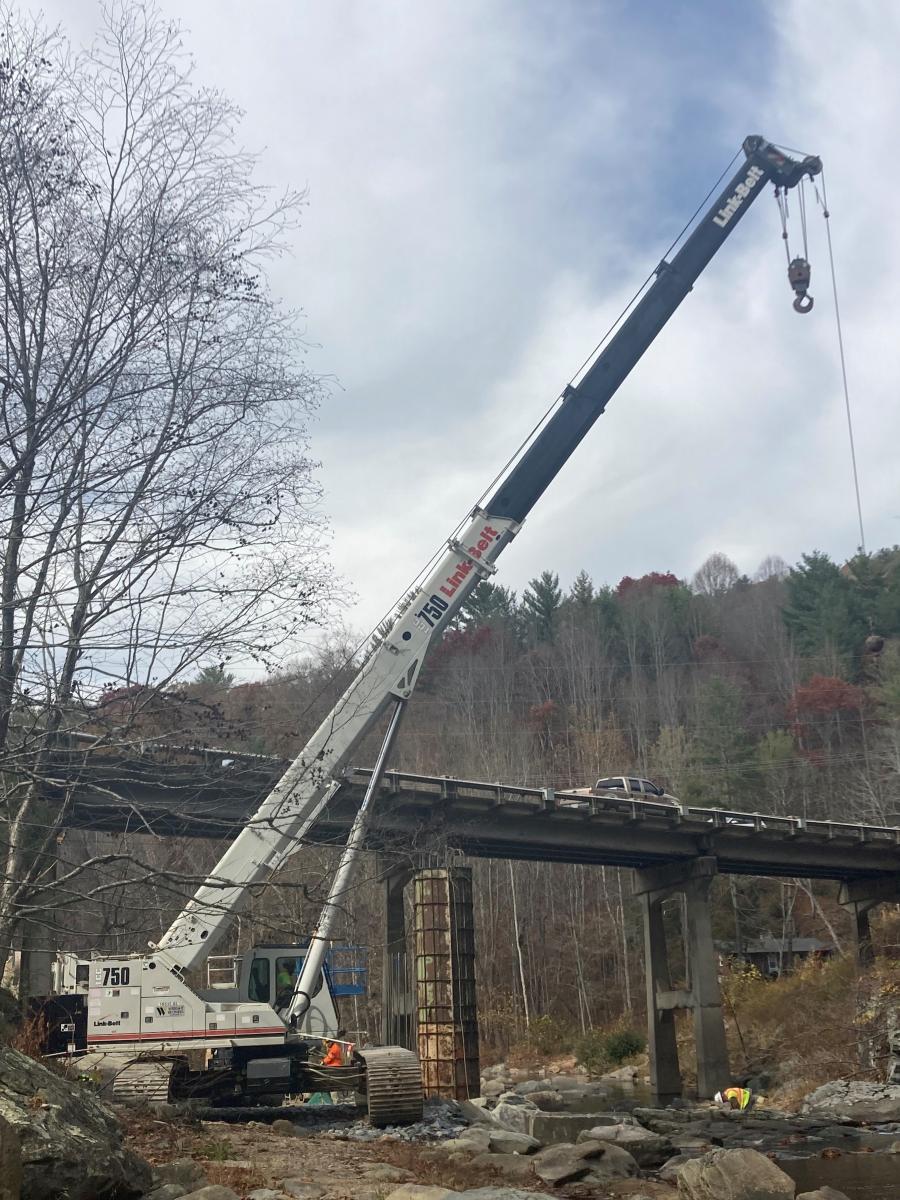A construction project began earlier this year in North Carolina’s Blue Ridge Mountains to expand a critical roadway and replace an aging bridge to help lessen traffic congestion in a much-traveled part of the state.
(Wright Brothers photo)
A construction project began earlier this year in North Carolina's Blue Ridge Mountains to expand a critical roadway and replace an aging bridge to help lessen traffic congestion in a much-traveled part of the state.
Wright Brothers Construction Co., based in Charleston, Tenn., was awarded the contract to replace the Watauga River Bridge on N.C. Highway 105 by the state's Department of Transportation (NCDOT) in November 2021.
It is the first step in a $95 million effort to widen 5.5 mi. of N.C. 105 and turn it into a divided four-lane highway from the small community of Foscoe north to the picturesque college town of Boone.
The first phase to build a longer, wider bridge over the mountain stream began in March when the contracting company began its clearing operations, which included removing a steep bank of vegetation, dirt and rock next to the structure.
The current 263-ft.-long Watauga River Bridge will be replaced in the final two phases to create a curved span 300 ft. in length and widened more than 100 ft. from the present span's 35-ft.-width to match the expansion of N.C. 105. The highway's two travel lanes will be widened to four with an added lane dedicated for turning west onto Broadstone Road and another for drivers to head east on Old Tweetsie Road.
Tanya Ball, project manager of Wright Brothers, explained that the $20.2 million bridge work at the intersection of N.C. 105 and Broadstone Road is a massive amount of work contained in a small footprint of less than a half-mile.
"Within the project there are several scopes of work: grading, drainage pipe, signals, walls and the bridge structure itself," she said. "It will give better and safer access to the Boone and Foscoe communities because it is estimated that more than 20,000 vehicles travel through that area every day. With this large expansion, all the existing roadways and intersecting roads will be brought up to current NCDOT standards with better sight lines and wider shoulders."
This short highway through the mountains, stretching just 17.7 mi. from Boone south to the community of Linville, is a critical route in what is known as North Carolina's "High Country."
In its announcement of the project last year, NCDOT noted its concern for the safety and mobility of motorists using N.C. 105, first opened in 1956. Additionally, the state agency said the almost 67-year-old Watauga River Bridge has reached the end of its service life and needs a replacement.
The structure is slated to be open for traffic sometime in 2024.
Spectacular Sights Attract Lots of Road Traffic
Heavy trucks rumbling up and over steep grades along the highway's two lanes are part of the reason for the need to expand N.C. 105, but tourists traveling by car account for most of the traffic on the highway.
The reason so many people use the highway is simple: The terrain and the vistas in this part of the Tarheel State's Blue Ridge Mountains are among the most visually stunning in the eastern United States.
The area includes both the highest peak and the deepest river valley east of the Mississippi River. Visitors stream to visit Mount Mitchell, with an elevation of 6,684 ft., and the spectacular Linville Gorge, with depths up to 3,000 ft. in places, during most months of the year.
The High Country also is noted for its cool spring and summer breezes, and the dazzling colors of the mountain forests in fall.
So it is that the region's very popularity demands a constant vigil by NCDOT to make sure roads like N.C. 105 continue to be in top form.
Bridge Site's Terrain Presents Challenges
Before Wright Brothers started its work on the Watauga River Bridge project, Ball said she and the other engineers in the company at once realized the worksite's terrain, so close to N.C. 105, would be the project's biggest challenge.
"The existing topography had 60-ft.- to more than 80-ft.-tall cut slopes hanging over the existing shoulders of the highway," Ball said. "This requires us to flag the traffic as a stop-and-go operation while we excavate the upper sections of each cut. This has extended the timeline of the excavation but is the only way to keep the traveling public safe during construction."
Another problem arose when Wright Brothers began to remove the hillside rock on the east side of the highway.
"The project was designed to have pre-split rock slopes at all the mountain cuts," she said. "When our crews pioneered into the cut slopes, we realized the rock did not go to the top of the mountains. The dirt and soft rock above the pre-split caused design issues. The rock can be presplit at a steeper slope than the dirt or soft rock. This has resulted in additional design and right-of-way purchasing by NCDOT."
The transportation agency is mitigating the future slide potential by installing soil nail walls with rock mesh or shotcrete facing in the areas of incompetent rock or dirt, she added.
"We also are proposing a boulder scape finish to the wall on Broadstone Road," said Ball. "This finish blends well into the natural landscape of the surrounding mountains."
So far, Wright Brothers has excavated the northern cut to an elevation that gives access to the slope stabilization crew and began excavation on the southern cut.
"Our subcontractor will install the slope protection from the top down to the excavated bench, then we will excavate that area more with the slope protection following each phase," she said. "We intend to move the crews around to the three main cuts so this work will be continuous until we reach road grade. This work likely will take up to a year to complete."
The cuts must be fully excavated, she added, before work can start on building the new Watauga River Bridge.
Two-Phased Bridge Replacement
Just feet from the junction of Broadstone Road and N.C. 105, Wright Brothers will not only perform the bridge replacement — both its demolition and reconstruction — but the roadway grading at the site as well.
The contractor will take down the bridge, built in 1955, based upon the structure's original blueprints given to them by NCDOT.
"We are fortunate to be supplied with these plans for our demo planning," Ball noted. "It is remarkable to see the hand drafted plans and the skill that was involved. The demo will occur at the beginning of the third year of the project in 2024."
NCDOT designed the curved bridge to be erected with one interior bent.
The first phase will build the larger structure east of the current bridge and be wide enough to move the existing traffic onto it, Ball explained. Next, Wright Brothers will tear down the old bridge and extend the width of the new structure in Phase Two. This approach keeps drivers moving across the Watauga River throughout the timeframe of the project.
She noted that each phase of the bridge construction will take one year to complete.
So far in 2022, Wright Brothers has employed about 20 people at the bridge site, in addition to the various subcontractor crews. During the bridge building and paving work in 2023 and 2024, Ball expects a total crew size of 35 folks.
She added that her company "is blessed" to have a team of North Carolina-based major scope subcontractors on hand, including Statesville's Maymead for the asphalt paving; Ameritech Slope Constructors in Asheville for the wall and slope stabilization; Hamptonville's Foothills Construction Services for the erosion and grassing; and MB Haynes, an Asheville electrical company, handling the signal work.
The beautiful Watauga River, from its headwaters only a few miles south of the bridge at Sugar Mountain, is an environmentally sensitive waterway throughout its 78-mi. path into eastern Tennessee. As such, Ball explained that Wright Brothers "is dedicated to conducting our construction activities in a non-invasive" manner.
"This project has plans and procedures set in place to minimize the impact and protect endangered species such as the Eastern Hellbender [the largest salamander species in North America]," she said. "The NCDOT also designed a biofiltration conveyance system that we are looking forward to building at the bridge site."
Moving Tons of Material Requires Top Equipment
As might be imagined, Wright Construction's crews have focused their attention on moving tons of earth and rock in 2022. Later, when the bridge construction begins, the company's subcontractors will tackle other specialized tasks to get the job done.
"The project has approximately 150,000 cubic yards of unclassified excavation," according to Ball. "We estimated nearly all of that would have to be mass blasted, [requiring] around 8,000 bore holes."
When the bridge replacement gets going next year, she added, plans call for more than 1,200 ft. of storm drainage pipe; 8,700 tons of asphalt; 2,000 ft. of curb and gutter; 1.4 million lbs. of structural steel girders; 300,000 lbs. of reinforcing rebar; 815 ft. of 14-in. steel piles; and 1,400 cu. yds. of concrete.
Of course, all those materials and their use at the Watauga River Bridge crossing will mean Wright Brothers needs to bring in a variety of equipment and tools of all sizes, among them cranes, excavators and rock-drilling machines.
Ball said her company has utilized several Caterpillar machines on the project so far in 2022, including a D5N dozer, a D6T dozer, a 905H wheel loader and a 323F medium-sized excavator. In addition, it has a Link-Belt TCC-750 crane on site, as well as a Broce RC350 Broom and a Terex Reedrill model 345 drill.
Stowers Machinery, an eastern Tennessee equipment dealer with locations in Chattanooga, Crossville, East Knoxville, Sevierville, the Tri-Cities and West Knoxville, is the provider for most of Wright Brothers' fleet.
"Our structural steel girder erection also will require renting cranes of a large scale," Ball explained.
When that time comes, Wright Brothers will turn to Crane & Rigging Corp., headquartered in Yadkinville, N.C., she said. The company also has High Country branches nearby in Blowing Rock and Asheville.
"We also rent various short-term equipment for the day-to-day operations, such as a water truck, pump or trailer," Ball added.
Experienced Contractor
Wright Brothers has been performing large-scale, heavy civil construction projects since 1961, when two brothers, James and Robert Wright, decided to borrow their father's bulldozer and work together helping their neighbors dig out ponds.
Today, Wright Brothers is a regional full-service civil and industrial building firm with annual revenues of approximately $200 million. It has completed over $1.3 billion in heavy civil, highway, concrete structures and paving contracts in just the last 10 years, including more than 150 bridges. The company also employs more than 600 people at full production and owns more than 400 pieces of construction equipment.
Among Wright Brothers' services are asphalt paving, rock and earth excavation, rock drilling, blasting, crushing, and screening, in addition to graded stone placement, storm drainage installation, leachate collection installation, foundation work, steel erection, utility installation, miscellaneous concrete construction and erosion control installation.
Its service area includes Alabama, Georgia, Kentucky, Mississippi, Tennessee, Virginia and the two Carolinas. CEG
Today's top stories




























